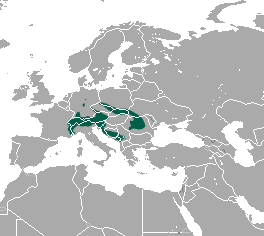Alpine shrew facts for kids
Quick facts for kids Alpine shrew |
|
|---|---|
| Conservation status | |
| Scientific classification | |
| Genus: |
Sorex
|
| Species: |
alpinus
|
 |
|
| Alpine Shrew range | |
The alpine shrew (Sorex alpinus) is a small mammal that belongs to the shrew family. It lives in the high mountains and forests of central and southern Europe.
Contents
What Does the Alpine Shrew Look Like?
The Alpine shrew is a small animal. It is about 6 to 7.7 centimeters (2.4 to 3 inches) long. This measurement does not include its tail, which is as long as its body! It weighs between 5.5 and 11.5 grams (0.2 to 0.4 ounces). That's about the weight of a few paper clips.
Its fur is a uniform greyish-black on its back. Its belly is a greyish-brown color. The tips of its teeth are reddish-brown. It has a long, pointed nose, tiny black eyes, and round, pink ears. Its legs and feet are white. The underside of its hairy tail is yellowish. Young Alpine shrews are a bit lighter in color than adults.
How to Tell it Apart from Other Shrews
The Alpine shrew lives in the same areas as the common shrew (Sorex araneus) and the Eurasian pygmy shrew (Sorex minutus). However, you can tell the Alpine shrew apart. It has darker fur and a longer tail than these other shrews.
Where Do Alpine Shrews Live?
The Alpine shrew lives in the mountains and uplands of Central and Eastern Europe. You can also find them in parts of France. Their home includes the Alps, the Black Forest, and the Jura Mountains. They also live in the Carpathian Mountains and other mountain ranges.
Alpine shrews live in Alpine meadows. They also live in coniferous forests. These are forests with trees like pine and fir. They can be found at heights between 200 and 2500 meters (about 650 to 8200 feet) above sea level.
Preferred Habitats
Sometimes, they live above the tree line. This is the height where trees stop growing because it's too cold. But usually, they prefer damp areas. They like wet pastures and swampy ground. They often live near small streams. They also like areas with small, scattered conifer trees.
Alpine shrews tend to hide in thick plants. They live in cracks in rocks. They also make their homes under large rocks or fallen tree branches. You might even find them near mountain huts.
Past Sightings
The Alpine shrew was once seen in the Spanish Pyrenees mountains. This was in the early 1900s. However, they haven't been seen there in many years. Scientists believe they are now locally extinct in that area. This means they no longer live there.
How Do Alpine Shrews Behave?
The Alpine shrew is a nocturnal animal. This means it is active mostly at night. It is a very good climber. It uses its long tail to help it balance as it climbs.
Like other shrews, it has a very fast metabolism. This means its body uses energy quickly. Because of this, it needs to eat very often to stay alive.
What Do They Eat?
Alpine shrews eat many different small creatures. Their diet includes insects, spiders, snails, and earthworms.
Who Eats Them?
Alpine shrews are also prey for other animals. This means they are hunted and eaten by predators. Some of their predators include foxes, weasels, domestic cats, and tawny owls.
What is the Alpine Shrew's Status?
The Alpine shrew is listed as "Near Threatened" by the IUCN. The IUCN is a group that keeps track of how endangered animals are. "Near Threatened" means the species might become endangered soon.
This is because Alpine shrews live in many separate mountain regions. Their numbers seem to be slowly going down. They might be threatened by habitat destruction. This happens when their natural homes are damaged or destroyed. For example, building hydro-electric power plants or increasing tourism can harm their environment.
The Alpine shrew used to live in the Pyrenees mountains. But it has not been seen there for many years. It may no longer exist there. It also hasn't been seen recently in the Harz Mountain region of Germany.


